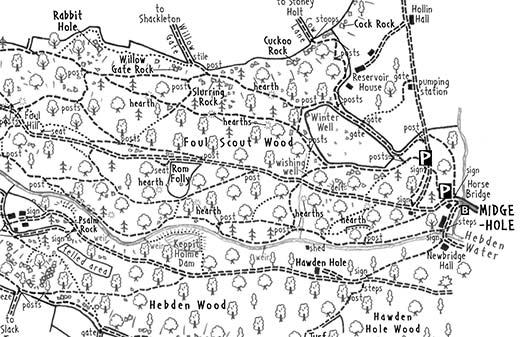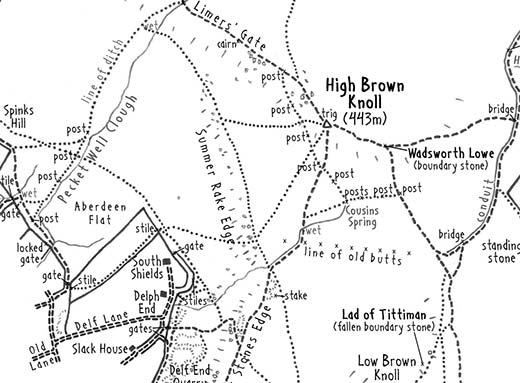
Chris Goddard
Local writer and storyteller, George Murphy interviews local characters and personalities
Introduction
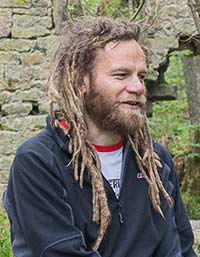 Chris Goddard was fascinated by maps and map making from an early age.
Chris Goddard was fascinated by maps and map making from an early age.
Discover how he graduated from making childhood maps of his locality and on family trips to exotic locations, to become a successful writer, illustrator and cartographer.
He also reveals his taste in music, how he met his partner, what luxuries he would want to take on a desert island and much more.
Photo: Mick Ryan
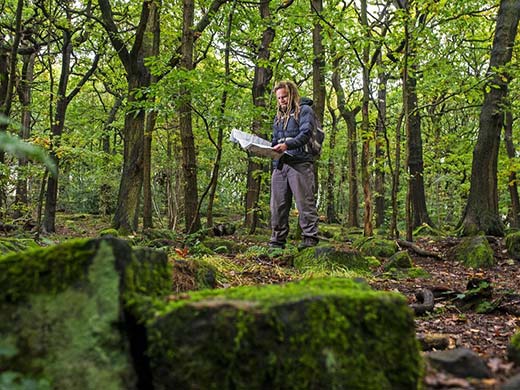
Questions and Answers
Chris, were you interested in map making from an early age?
Yes, I don't know exactly when, but I do remember being very good at map jigsaws as a boy and would draw maps everywhere we went on holiday. It wasn't long before I was the one holding the map on walks or car journeys, but I had no idea this was what I would end up doing.
Can you describe yourself as a teenager? Were you studious?
Yes, I was very quiet and diligent at school, but probably far more in my element in the outdoors, whether at Scouts or doing the Duke of Edinburgh Award. In so many of the pictures of me I'm wearing hiking boots and standing on top of a mountain in Wales or the Lake District.
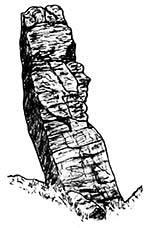 You studied Geography at Cambridge. I knew a student in the 70s who did 6 month field trips to the Arctic but failed the maths part of his geography degree. How was your course?
You studied Geography at Cambridge. I knew a student in the 70s who did 6 month field trips to the Arctic but failed the maths part of his geography degree. How was your course?
It was an incredible opportunity to broaden my horizons and geography was the one subject that allowed me to move from a more scientific bent to being interested in social and cultural issues. Sadly there were no six month field trips, but I did manage a free trip to India to do my dissertation, the title of which had to be changed as we caught a train 10 hours in the wrong direction – not very impressive for a geographer, but it was through the night!
Did your degree lead to geography related employment?
I suppose so, though everyone jokes that it leads only to teaching geography. I knew I wanted to work outdoors and was fortunate to land my dream job, walking all the footpaths in the Lake District. Remarkably they couldn't appoint anyone at the first round of interviews, so I got a chance and ended up working for the National Park Authority for 2 years and meeting my partner Caroline there.
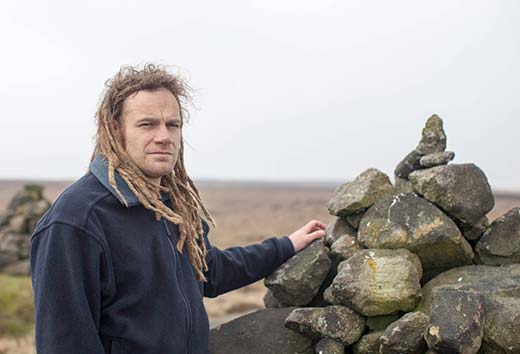
Photo: James Cook
When you moved to Hebden Bridge, were you inspired to start mapmaking again?
Well, I'm not sure I ever really stopped, but it did inspire me to start work on what would become The West Yorkshire Moors. At first I was just mapping where all the paths were on Midgley and Wadsworth Moors so I could find my own way and make sense of the maze of paths up there when the mist comes down. But as I began to explore further afield, an idea for a book began to take shape. It would take around eight years for it to come to fruition with all the sketches and historic research and, when I launched it, I swore I would never embark on something as foolishly labour-intensive again.
That book established your name. Reviewers compared your maps and annotations to Wainwright's Lakeland guides. Apart from being a well deserved compliment, what were your thoughts on that comparison?
 I am very flattered by these comparisons. Though I was obviously influenced by Wainwright's books, I intentionally never looked at those on my shelf during the writing of that first book because I didn't want to copy his style too closely, and hopefully I ended up with something that is my own distinctive style. It should be pointed out that, having produced my books using GoogleEarth, Photoshop and various other technological advantages, I am even more in awe of his work and how he was able to produce such accurate maps without these tools.
I am very flattered by these comparisons. Though I was obviously influenced by Wainwright's books, I intentionally never looked at those on my shelf during the writing of that first book because I didn't want to copy his style too closely, and hopefully I ended up with something that is my own distinctive style. It should be pointed out that, having produced my books using GoogleEarth, Photoshop and various other technological advantages, I am even more in awe of his work and how he was able to produce such accurate maps without these tools.
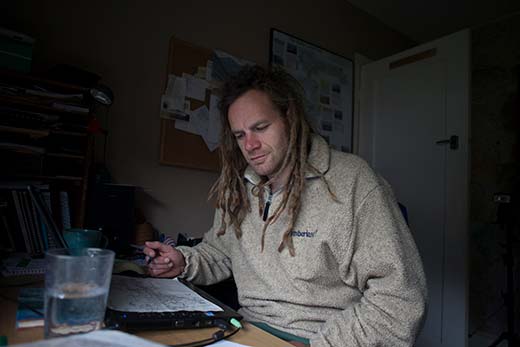
Photo: James Cook
I began to notice your books in railway stations and local cafes. I've recently started to read The West Yorkshire Woods and was struck by the amount of text and the explanatory illustrations. How long did it take you to complete that book?
I've got a lot quicker since that first book, partly out of necessity and partly because it has become my full-time work, so The West Yorkshire Woods Part I and subsequent titles have each taken about two years. The walking and exploring is only a small part of it, with map-drawing, sketching and historical research dwarfing the 'fun' bit, so I'm actually far more desk-bound than people imagine.
Sample of Chris Goddard's map making - click on map to enlarge
We're both fans of Under the Rock. When The Gallows Pole was a success did you approach Ben Myers with the idea for a trail guide to Coiners' Country?
It was actually someone at the Book Case/Book Corner bookshops who suggested the idea and introduced us to each other. Rather embarrassingly Ben knew my work but I hadn't read The Gallows Pole at that point, but it came together very quickly and has proven very popular. In fact it's the only walk I've created where work has had to be done to improve the paths as so many people are visiting, so I was very fortunate jumping on Ben's coattails before he went stratospheric.
Did the museum service commission your guide to Anne Lister? How closely do you work with your clients?
Yes, they did suggest me producing an Anne Lister Walk map and work with me on the route, but none of my publications are really client commissions. I have financed them myself, which is cleaner and also means I have complete control over the design and content of my work. I'm very particular about how the maps look and, when I've let other people do something with them (in other publications or in magazines), I often don't like the results.
Sample of Chris Goddard's map making - click on map to enlarge
How did Lockdown affect your work?
Caroline and I both work from home, so in some ways it didn't make much difference. I was lucky that I'd done most of the research for The West Yorkshire Woods Part II prior to lockdown, so I was mainly putting the book together. It did mean I couldn't do as much research in the libraries and archives as I normally do, but compared to a lot of people I was very fortunate.
You're also a DJ. What type of music features in your gigs?
We do a night called Kismet and it's a very eclectic mix of world music and dance music, so there's not much we don't cover. I just play lots of different things that I like dancing to, whether that's bouncy Balkan brass, filthy dubstep or bhangra'n'bass.
Have you got a favourite holiday destination?
Not really, as a family we always used to go to Barmouth in North Wales and I thought it was a magical place until I went back as an adult. Nowadays I'm always going to different places around the UK with my work and I love how much of the country I've been able to get to know. I do prefer seeing something new over the familiar – after all isn't that why we go on holiday in the first place?
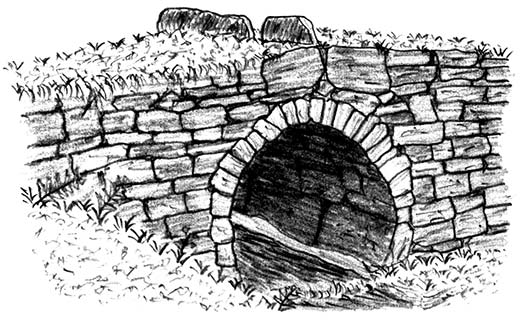
If you were shipwrecked on Desert Island Discs, what luxuries would you choose? Would you be able to survive?
A pen and notepad, so that I could at least draw. I'd like to think I'd be pretty resourceful and, by the time I was rescued, I'd have a series of maps of the island to show for it. In fact it's starting to sound quite appealing.
Which book would you save from the waves?
My favourite books, Lord of the Flies or The Heart of the Matter, are hardly survival manuals, so perhaps I'd just take On The Road, as close as I get to pure escapism.
Which disc would you rescue?
That's tough, but my favourite album was always The Manic Street Preachers' The Holy Bible. It would give me something to bounce around to, while shouting 'So damn easy to cave in, man kills everything!' at the waves as the sea level rises around me.
What advice would you give to young people?
Don't think you can plan out how your life or career is going to go and what you're going to end up doing. The best things happen by chance and circumstance.
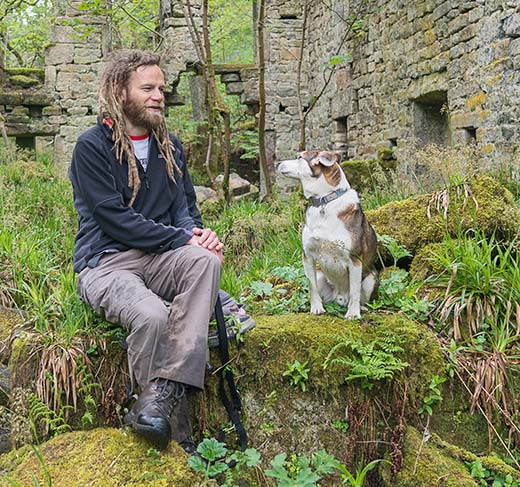
Photo: Mick Ryan
See also: Chris Goddard's website
More HebWeb interviews from George Murphy
If you would like to send a message about this interview or suggest ideas for further interviews, please email George Murphy


